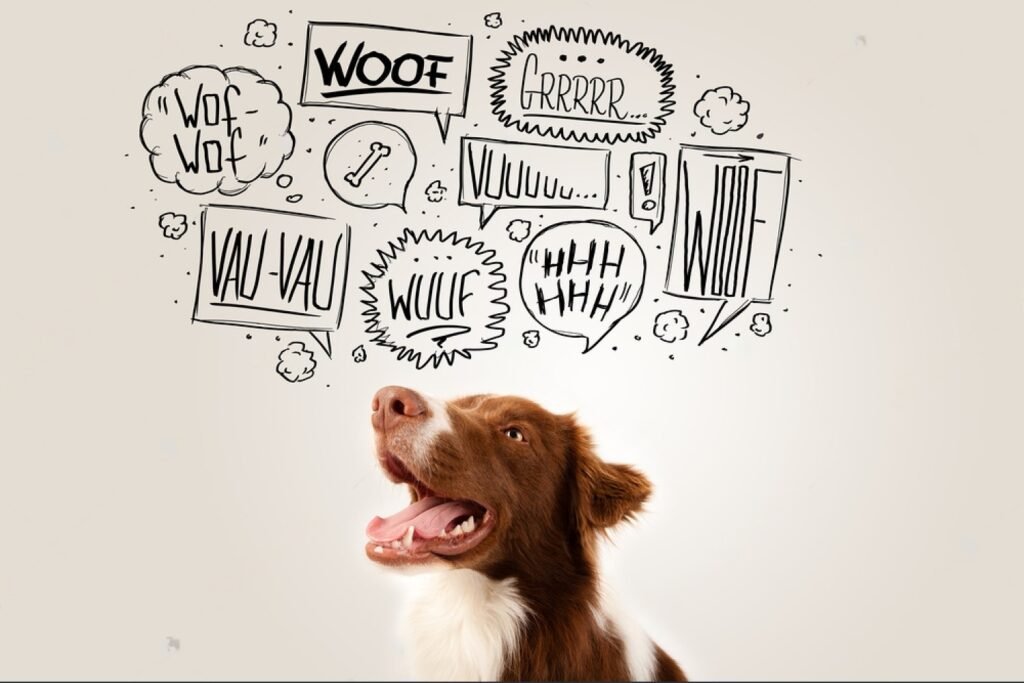Dogs can be very expressive, using various vocalizations, such as barks, whines, and growls, to communicate with other dogs, animals, and people. Here are some possibilities of what different dog sounds may mean and tips on how to better communicate with your dog.
Barks
Barks are the most used vocalization. They can mean various things, such as “I’m lonely,” “I am happy to see you,” or “There is a stranger in the backyard trying to break into the house.”
Here are a few common ways dogs use barking:
- To alert a person or another dog to danger.
- To express excitement or joy.
- To get attention.
- To request something.
- To express dominance.
Barking varies in volume, length, and tone. Barking also depends on the dog breed. The context of when, where, and how a dog barks helps determine its meaning. For example, a short, sharp bark may come from fear or aggression, while a longer bark with a low tone may be a request for attention.
Whines
Whining is a high-pitched vocalization that dogs often use to express emotions, from joy and excitement to distress and anxiety. Dogs may whine to communicate their need for food, attention, or comfort. The pitch or intensity of the whine provides clues about the dog’s emotional state.
For instance, a low, soft whine may indicate contentment. On the other hand, constant whining may indicate an intense emotional or physical need. Male dogs, for example, will often whine when in proximity to a female dog in heat. The female dog may be a block away, but the male dog can still smell her scent and whines to be with her.
A deep whine may come when a dog is in pain from an illness or injury. Dogs instinctively try to hide any weakness as part of their pack mentality. If a dog is whining or suddenly whimpering out of character, it could be due to a serious illness or injury. In this case, taking the dog to the veterinarian is appropriate.
Growls
Growling is a low, guttural sound used to express displeasure or warning. Growling warns other animals or people to back off. Take a growl seriously, as it can signify that a dog is agitated or feeling threatened. Growls are often a precursor to a dog bite, but not always.
There are different types of growls. Each has a different meaning. A deep, low growl may be a sign of aggression. A series of shorter, higher-pitched growls may indicate fear or distress.
History of Canine Communication
The history of dog barks, whines, and growls comes from their wild ancestors using vocalizations to communicate with other members of their dog pack. They allow a dog to convey various emotions and needs. Over time, these sounds became an important part of dogs’ communication with humans. Even children understand some dog sounds.
Interpretations and Misinterpretations

To accurately interpret dog barks, whines, and growls, it is important to consider the context, intensity, length, and tone of the barking. The context gives clues as to the meaning, while the volume, length, and tone come from the dog’s emotional state.
For instance, a short, sharp bark may indicate aggression, nervousness, timidity or alarm. A longer, lower-pitched bark may be a request for attention. A low, soft whine may indicate contentment, while a series of higher-pitched cries might be signs of distress. A deep, low growl may indicate aggression, and higher-pitched growls may show fear.
Examples of possible misinterpretations include mistakenly interpreting a bark as a sign of aggression when it may actually be a request for attention. Another example is mistaking a low, soft whine for contentment when it may actually be a sign of distress.
Telepathic Interspecies Communication
For those interested in taking dog communication to the next level, there are a few talented individuals in the world who are highly sensitive to animals with amazing skills in telepathic interspecies communication.
One example is Pea Horsely. She is the UK’s best-known animal communicator. She wrote a book entitled “The Animal Communicator Guide” and offers free online courses for those interested in learning more about this skill.
The easiest way to practice is to spend time quietly and calmly sitting with your dog in a place where you can share a peaceful moment without being disturbed. Using your mind, ask your dog an open-ended question, such as “Is there anything you would like to communicate to me?” or “Tell me what you want.”
Don’t be surprised if the answer comes in feelings rather than words. Be open to the experience, and you may gain some valuable insights. It takes practice to get in sync with your dog on this advanced communication level. A dog’s vocalizations are easier to interpret when you are in tune with your dog from enjoying this practice time together.
Final Thoughts
The bond you make with a beloved dog is something that you can enhance if you pay attention to what your dog is trying to say. With a little practice, you will learn how better to interpret what your dog is trying to communicate with vocalizations.
Don’t be afraid to ask your dog questions out loud if you are unsure what the dog is saying while you practice learning what your dog means by the sounds. Dogs may not understand all your words, but they definitely understand your energy and the tone behind the words.
Sources
Communication in Dogs
https://www.ncbi.nlm.nih.gov/pmc/articles/PMC6116041/
Do children understand man’s best friend? Classification of dog barks by pre-adolescents and adults
https://www.sciencedirect.com/science/article/abs/pii/S0168159111002978
What is Telepathic Interspecies Communication?
https://animalthoughts.com/what-is-telepathic-interspecies-communication/
Pea Horsley
https://www.healyourlife.com/authors/pea-horsley
Attribution
Author’s Byline
William Vinson is a professional writer with more than 40 years of experience. He is the Director of the nonprofit Willivision Foundation, which operates a dog rescue center. He is a music producer for the Play a Song – Save a Dog project of TheSound.com, and royalties earned from the music, support animal rescue efforts in the USA, Mexico, and Ukraine.

